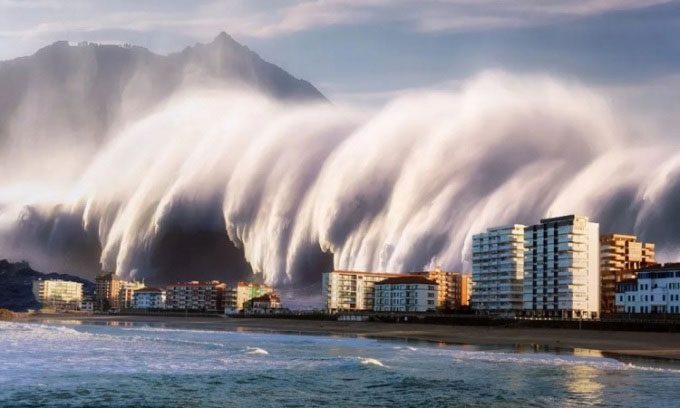Researchers believe that solar storms cannot directly cause tsunamis but may trigger earthquakes that lead to powerful waves.
The Sun frequently releases energy in the form of solar storms, ejecting plasma streams filled with charged particles that can severely affect satellites, the Internet, and GPS on Earth. With all that destructive power, could solar storms trigger tsunamis on Earth? The answer is not direct.

Some experts suggest that solar storms enhance earthquakes, potentially triggering tsunamis. (Photo: Mimadeo).
For a tsunami to form on Earth, an earthquake must create shockwaves beneath the ocean floor, causing water to shift and generate a massive, super-fast wave across the entire water column, according to the National Oceanic and Atmospheric Administration (NOAA). Such earthquakes can be caused by the same tectonic plate movements that lead to volcanic eruptions and city tremors. While plasma winds from solar flares (powerful electromagnetic radiation bursts) or coronal mass ejections (huge clouds of charged particles moving at high speeds from the Sun) sweeping across Earth may seem frightening, they cannot directly cause tsunamis to rise from the ocean floor.
However, some researchers suggest that solar storms may indirectly lead to tsunamis on Earth. Scientists agree that solar storms can create shock waves that cause chaos on the Sun. This phenomenon was recorded by the Solar Terrestrial Relations Observatory (STEREO) in 2006. The shock waves, known as Moreton waves, are strong enough to compress and heat hydrogen gas and other gases on the Sun until the entire star burns brighter. This process occurs in just a few minutes.
Some solar eruptions are so powerful that they leave traces on Earth. In a study published this year in the journal Nature, scientists unearthed evidence of an eruption that swept over Greenland more than 9,000 years ago. Particles carried by the solar wind got trapped in the ice core. This significant event did not trigger a tsunami, but a 2020 study in the journal Scientific Reports described the connection between solar storms and strong earthquakes on Earth, which can cause tsunamis.
“We found evidence of a correlation between major earthquakes worldwide and the density of photons near the ionosphere, due to solar wind,” said the research team led by Vito Marchitelli, a satellite analyst at the University of Basilicata in Potenza, Italy.
Solar storms affecting Earth result from solar flares or coronal mass ejections, which often occur when magnetic fields become tangled or break apart. Both explode with immense energy and shoot solar winds into space. When charged particles in the solar wind reach Earth and interact with the ionosphere, the outermost layer of Earth’s atmosphere at the edge of space, they can disrupt satellite and GPS signals. However, interaction with the magnetosphere can be even more harmful. This is the region surrounding the planet with an exceptionally strong magnetic field.
Marchitelli and colleagues propose that particles in the solar wind colliding with the magnetosphere may influence earthquake intensity. They suggest that these particles could be related to tectonic plate movements because their charge exacerbates existing disturbances like subduction (the process of one tectonic plate sliding beneath another). According to them, the more photons collide with the magnetosphere, the more likely they are to increase earthquakes that cause tsunamis. However, Marchitelli’s research did not examine the number of tsunamis during periods of strong and weak solar winds, so it remains a hypothesis.
A 2011 study published in the journal Scientific Research observed an increase in earthquakes during the peak periods of the Sun’s 11-year cycle when the star is most active and likely to release solar winds that distort Earth’s magnetic field. This could add pressure to the crust by compressing the Earth’s magnetic field against the tectonic plates below, affecting earthquake activity.


















































